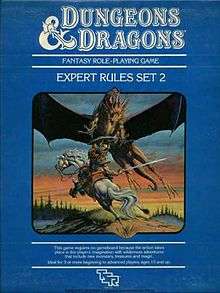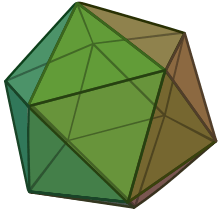Dungeons & Dragons Expert Set
|
The cover of the 1981 Expert Set rule book; cover art by Erol Otus | |
| Author |
David Cook (1981 version) Frank Mentzer (1983 version) |
|---|---|
| Genre | Role-playing game |
| Publisher | TSR |
Publication date | 1981, 1983 |
The Expert Set is an expansion boxed set for the Dungeons & Dragons fantasy role-playing game. It was first published in 1981 as an expansion to the Basic Set.
Publication history
1981 version
The Basic Set saw a major revision in 1981 by Tom Moldvay.[1] The overarching goal of the revision was to provide subsequent expansions to the game, each describing a specific set of levels of character development.[2] The Basic Set described character levels 1 through 3, as had its immediate predecessor, the Basic Set edited by J. Eric Holmes in 1977. The Moldvay Basic Set was immediately followed by the release of the Expert Set edited by Dave Cook, supporting character levels 4 through 14.[3] The Isle of Dread was included in the set as an example of an outdoor adventure and setting.[4] The set included dice, and featured cover art by Erol Otus.[5]
1983 revision

The Basic Set was revised once more in 1983 by Frank Mentzer, this time as Dungeons & Dragons Set 1: Basic Rules. Between 1983 and 1985 this system was revised and expanded by Mentzer as a series of five boxed sets, including the Basic Rules, Expert Rules (supporting character levels 4 through 14),[6] Companion Rules (supporting levels 15 through 25),[7] Master Rules (supporting levels 26 through 36),[8] and Immortal Rules (supporting Immortals - characters who had transcended levels).[9] The first four sets were later compiled as a single hardcover book, the Dungeons & Dragons Rules Cyclopedia (1991).[10]
The Mentzer Expert Set featured art by Larry Elmore, and was published as a boxed set with dice and two books: the 64-page Expert Set rule book and the 32-page (with an outer folder) module Isle of Dread.[5][11]
The 10th Anniversary Dungeons & Dragons Collector's Set boxed set, published by TSR in 1984, included the rulebooks from the Basic, Expert, and Companion sets; modules AC2, AC3, B1, B2, and M1, Blizzard Pass; Player Character Record Sheets; and dice; this set was limited to 1,000 copies, and was sold by mail and at GenCon 17.[5]:147
Contents
Unlike the other four box sets (Basic Rules, Companion Rules, Master Rules, and Immortal Rules), which each contain a players manual and a separate Dungeon Masters rulebook, the Expert Set consists of only one rulebook and then an adventure module, X1-The Isle of Dread.[5][11] The Expert Set rulebook covers character levels 4-14,[6]:2 and begins with an introduction to wilderness adventures and playing a long-term campaign.[5]
The rulebook is then divided into a Player's section and a Dungeon Master's section. The Player's section introduces rules for adventuring in the wilderness, as well as new weapons and equipment. It expands the spell lists for the cleric and magic-user classes, and introduces the concept of "reversed spells" (in which some spells may be cast with a result opposite to their normal effect). Because of their special abilities, the three demi-human classes are given maximum levels "to help keep all the character classes in balance":[6]:3 dwarves, elves, and halflings can only raise to 12th, 10th, and 8th level, respectively. When any character reaches a specified "Name" level, depending on their class, they are permitted to build a stronghold, and thus attract lower-level NPC followers.
The bulk of the Dungeon Master's section provides details for creating and running both wilderness adventures and a long-term campaign, including designing the home town and area of player's characters, and combat rules for various wilderness terrain. The Grand Duchy of Karameikos is presented as a sample wilderness adventure area.[6]:38–39 The lists of magical items and monsters are also expanded.
Players who want further expansion are directed to the Companion Set.[5]
Reception
Chris Hunter reviewed the 1983 edition for Imagine magazine, giving it a positive review. He thought that, unlike the Basic Set, this was more of a re-organization and re-editing of the original material.[11]
References
- ↑ Gygax, Gary, and Dave Arneson [1974], edited by Tom Moldvay. Dungeons & Dragons Basic Set (TSR, 1981)
- ↑ Gygax, Gary (December 1978). "Dungeons & Dragons: What Is It and Where Is It Going?". The Dragon #21. TSR. III (8): 29–30. ISSN 1062-2101.
- ↑ Gygax, Gary, and Dave Arneson [1974], edited by Dave Cook. Dungeons & Dragons Expert Set (TSR, 1981)
- ↑ Winter, Steve (2007). "Designer Tom Moldvay". Wizards of the Coast. Retrieved 2007-10-04.
- 1 2 3 4 5 6 Schick, Lawrence (1991). Heroic Worlds: A History and Guide to Role-Playing Games. Prometheus Books. p. 133. ISBN 0-87975-653-5.
- 1 2 3 4 Gygax, Gary, and Dave Arneson [1974], edited by Frank Mentzer. Dungeons & Dragons Set 2: Expert Rules (TSR, 1983)
- ↑ Mentzer, Frank. Dungeons & Dragons Set 3: Companion Rules (TSR, 1984)
- ↑ Gygax, Gary, Frank Mentzer. Dungeons & Dragons Set 4: Master Rules (TSR, 1985)
- ↑ Mentzer, Frank. Dungeons & Dragons Set 5: Immortal Rules (TSR, 1986)
- ↑ Allston, Aaron, Steven E. Schend, Jon Pickens, and Dori Watry. Dungeons & Dragons Rules Cyclopedia (TSR, 1991)
- 1 2 3 Hunter, Chris (July 1984). "Game Reviews". Imagine (review). TSR Hobbies (UK), Ltd. (16): 38–39.
Additional reading
Reviews: Different Worlds #12 (1981), The Space Gamer #38 (1981)

